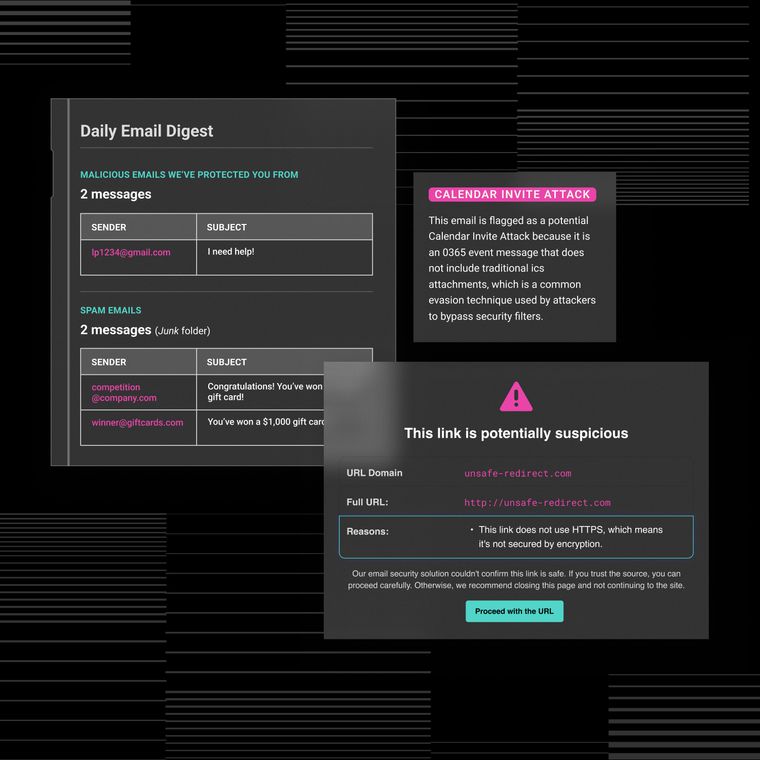Stay Ahead of Cyber Threats With Advanced BEC Solutions Powered by AI
Protect your organization against modern, advanced BEC threats with AI-driven cybersecurity solutions.
June 12, 2025
Email remains your largest and most targeted attack surface, and cybercriminals know it. As modern email threats become increasingly sophisticated and business email compromise (BEC) tactics evolve, legacy security measures no longer offer sufficient protection.
Basic email security solutions rely on outdated methods:
Rule-Based Filtering: Blocking emails based on predefined parameters.
Signature-Based Detection: Identifying known malware patterns.
Spam Filtering: Using keywords or blacklists.
Basic Phishing Detection: Focusing on suspicious links or domains.
These reactive approaches only stop threats they've already seen, leaving organizations exposed to never-before-seen attack methods, including advanced BEC schemes.
Today’s threat landscape demands a shift toward proactive defenses powered by AI and behavioral analysis
Why Organizations Need Advanced BEC Solutions
Advanced BEC solutions proactively detect suspicious behavior, analyze anomalies in sender-recipient patterns, and prevent attacks before they reach end users.
Organizations face a widening gap between traditional email defenses and modern threats as BEC attacks grow more sophisticated. Legacy security tools, like spam filters and signature-based detection, aren’t equipped to stop targeted attacks that contain no malicious links, attachments, or malware.
Organizations increasingly need advanced BEC solutions because:
Threat Actors Are Using AI and Social Engineering: Cybercriminals now craft highly convincing emails that closely mimic legitimate communications, making manual and rule-based detection extremely difficult.
Attack Volumes Are Overwhelming Security Teams: Security teams face an unmanageable volume of threats, and manual investigation alone is no longer scalable.
Compliance Pressures Are Increasing: Regulations like GDPR, HIPAA, and CCPA require proactive monitoring and reporting of security incidents, raising the stakes for missed threats.
Traditional Solutions Miss Behavioral Anomalies: Static rules and signature-based defenses fail to recognize subtle deviations in communication patterns that often indicate compromise.
By leveraging AI, machine learning, and behavioral analysis, modern security solutions adapt dynamically to evolving attacker tactics.
Platforms like Abnormal deliver this level of protection through cloud-native integrations, real-time anomaly detection, and behavioral AI engines that continuously learn from legitimate communication patterns to better spot abnormal activity.
Core Components of Modern Email Security Solutions Against Advanced BEC
Advanced BEC solutions combine multiple technologies to proactively detect, analyze, and stop sophisticated impersonation attacks before they reach users.
Effective solutions share several critical components that work together to deliver comprehensive protection.
AI and Machine Learning for Threat Detection
AI and machine learning form the backbone of modern email defenses. These technologies:
Analyze massive datasets to identify emerging threat patterns.
Establish baselines of normal communication behaviors.
Detect subtle anomalies without relying on static threat signatures.
Adapt dynamically to new attacker tactics in real time.
Instead of flagging only known threats, AI-driven solutions detect never-before-seen attacks based on deviations from expected behavior, offering protection traditional systems cannot match.
Advanced Threat Prevention Against Sophisticated Attacks
Advanced BEC solutions layer multiple detection techniques to prevent delivery of malicious emails. Effective platforms offer:
Pre-delivery inspection of content, URLs, attachments, and sender reputation.
Zero-day detection using sandboxing, machine learning, and heuristic analysis.
Post-delivery monitoring to identify threats missed at first glance.
This multi-layered prevention model stops sophisticated phishing, invoice fraud, vendor compromise, and impersonation attempts.
Data Loss Prevention Integration
Data loss prevention (DLP) ensures sensitive information doesn’t leave the organization unintentionally. Leading platforms:
Classify sensitive content and apply appropriate protection policies.
Detect risky behavior, such as sending sensitive data to unauthorized recipients.
Integrate seamlessly with enterprise DLP strategies across cloud environments.
Behavioral insights further enhance DLP by spotting unusual outbound communication patterns that could signal insider threats or account compromise.
User Authentication and Identity Protection
Authentication and identity validation form a critical layer of advanced email security. Solutions reinforce protection by:
Enforcing DMARC, SPF, and DKIM standards to verify sender authenticity.
Monitoring login behaviors to detect account takeover attempts.
Integrating with multi-factor authentication systems to block unauthorized access.
Analyzing device usage, geolocation, and session patterns for anomalies.
These measures help prevent impersonation attacks and detect compromised accounts before attackers can exploit them.
Advanced Implementation Strategies
Deploying an advanced email security solution successfully requires careful alignment with your organization's infrastructure, operational priorities, and broader security strategy. Implementation choices, especially around deployment models, integration workflows, and automation, directly impact your ability to defend against sophisticated BEC threats.
Selecting the Right Deployment Model
Choosing between cloud, on-premises, or hybrid deployment models shapes how your email security platform operates and scales.
Cloud-native solutions offer rapid deployment, automatic updates, and scalability to protect globally distributed workforces. They reduce maintenance overhead and enable continuous improvements as threats evolve.
On-premises deployments provide greater control over data privacy, customization, and regulatory compliance for organizations with strict sovereignty requirements.
Hybrid approaches combine the benefits of both, allowing sensitive data to remain in-house while leveraging the scalability of cloud-based threat detection.
When selecting a deployment model, evaluate:
Data sensitivity and compliance obligations
Existing infrastructure and cloud maturity
Geographic distribution of users and assets
Budget constraints and resource availability
Integration needs with other security systems
The right model ensures your defenses evolve alongside both your operational needs and the threat landscape.
Integrating Seamlessly with Existing Security Systems
Email security must integrate tightly with your broader security architecture to maximize visibility, accelerate detection, and enable coordinated responses.
Leading platforms use API-based integrations that connect directly to Microsoft 365, Google Workspace, and security ecosystems without rerouting email traffic. API-driven approaches provide faster deployment, richer visibility into communication patterns, and deeper automation across the security stack.
Critical integration points include:
Security Information and Event Management (SIEM) platforms for centralized telemetry
Security Orchestration, Automation, and Response (SOAR) systems for automated workflows
Identity and Access Management (IAM) tools for correlating user behaviors
Threat intelligence platforms for enhancing detection with external data
A fully integrated email security system helps your SOC act faster, respond smarter, and better defend against sophisticated email-based attacks.
Automating Response and Remediation
Automating detection, investigation, and remediation processes reduces response times, minimizes attacker dwell time, and lightens the load on security teams.
Capabilities to prioritize include:
Automated quarantine of suspicious emails before user interaction
Dynamic analysis of unusual communication patterns after deliver
Real-time post-delivery remediation to retract threats from all mailboxes once identified
Account lockout automation if signs of credential compromise are detected
Forensic evidence collection to support investigations and compliance
Platforms like Abnormal provide instant remediation once a threat is detected, removing dangerous messages across the organization in seconds without relying on user reporting.
By deploying these automated capabilities, organizations dramatically shrink the window of opportunity for attackers while improving incident response consistency and speed.
Best Practices for Implementing Advanced BEC Solutions
Successful deployment of advanced email security solutions strengthens protection against sophisticated threats without disrupting business operations.
Strategic planning, phased rollouts, ongoing user education, and continuous optimization ensure your defenses evolve alongside the threat landscape.
Start with Phased Deployment
A phased, risk-based rollout protects high-value users early while minimizing operational disruption.
Begin with executives, finance teams, administrators, and other users most frequently targeted in attacks. Pilot deployments allow you to:
Validate that legitimate emails are delivered properly
Confirm security controls do not block critical communications
Test user reporting and remediation workflows
Effective change management is critical. Communicate the implementation timeline, explain security benefits, and prepare users for potential changes in how email threats are handled.
A typical enterprise deployment roadmap:
Setup and configuration (one to two weeks)
Pilot deployment to high-risk departments (two to four weeks)
Evaluation, feedback, and system adjustments (one to two weeks)
Gradual rollout to remaining departments (four to eight weeks)
Full deployment and operational handoff (one to two weeks)
API-based email security platforms compress these timelines significantly, allowing organizations to deploy advanced protection without rerouting mail traffic or interrupting user workflows.
Prioritize User Training and Awareness
While AI-powered email security blocks the majority of threats, educated users serve as a critical secondary defense.
Strengthen user awareness with:
Short, regular training sessions tied to real-world threat examples
Clear, accessible reporting mechanisms for suspicious emails
Recognition programs that reward threat reporting
Communication of success metrics to reinforce program value
Security awareness training must evolve over time. Regularly update materials to reflect new phishing tactics, and use simulated phishing exercises that mirror actual attack techniques to strengthen resilience.
Optimize Continuously for Maximum Protection
Maintaining peak effectiveness requires proactive tuning and threat intelligence integration.
Key practices include:
Reviewing quarantined emails to fine-tune filtering accuracy
Creating safe sender lists with dynamic monitoring for changes in behavior
Implementing user-driven feedback loops for false positives
Adjusting system sensitivity based on threat trends and business tolerance for risk
Integrating external threat intelligence sources further improves detection by:
Subscribing to industry-specific intelligence feeds
Participating in threat-sharing communities
Leveraging vendor-provided intelligence across a broad customer base
Regular security assessments validate system performance. Conduct quarterly reviews of detection metrics and user feedback, and include email attack simulations in annual penetration testing exercises.
Advanced platforms that leverage behavioral analysis naturally maintain high accuracy with minimal manual tuning. By continuously learning what normal communication looks like, these solutions reduce false positives while adapting to new threats automatically.
Evaluating the Impact of Advanced BEC Solutions
Maintain strong protection against evolving email threats by continuously measuring how well your advanced BEC solution performs against key security and operational benchmarks.
Track the Right Performance Indicators
Monitor key email security metrics to validate the effectiveness of your solution:
Threat Detection Rate: Percentage of phishing, malware, and business email compromise (BEC) attempts successfully blocked before reaching user inboxes.
Mean Time to Detect (MTTD): Average time it takes to identify a malicious email after it enters your environment.
Mean Time to Respond (MTTR): Average time from detection to complete remediation of an email-based threat.
False Positive Rate: Percentage of legitimate emails incorrectly flagged as threats, impacting user productivity.
Helpdesk Ticket Volume: Number of employee-reported email security incidents requiring IT or security team intervention.
High detection accuracy combined with low disruption is critical to maximizing the impact of your advanced BEC solution.
Analyze Total Cost of Ownership
Go beyond upfront licensing costs to evaluate total value:
Speed of deployment and ease of integration with existing infrastructure.
Administrative workload and ongoing management needs for security teams.
Long-term scalability to support organizational growth and emerging threat volumes.
Solutions powered by AI and behavioral analysis, like Abnormal, minimize maintenance needs and future-proof your defenses as attackers evolve.
Build a Stronger Defense Against Advanced BEC Threats
Modern email security starts with smarter defenses. By combining native cloud protections with intelligent, behavioral-based platforms, organizations can detect and stop sophisticated threats like advanced BEC.
Solutions like Abnormal use Human Behavior AI to deeply understand user communication patterns, spotting anomalies that traditional tools miss. This proactive, adaptive approach delivers stronger protection against AI-driven threats, social engineering attacks, and evolving BEC tactics.
As threats grow more complex, forward-thinking security teams are choosing solutions that continuously learn and evolve.
Ready to stay ahead of advanced email attacks? Book a demo to learn more.
Related Posts
Get the Latest Email Security Insights
Subscribe to our newsletter to receive updates on the latest attacks and new trends in the email threat landscape.


